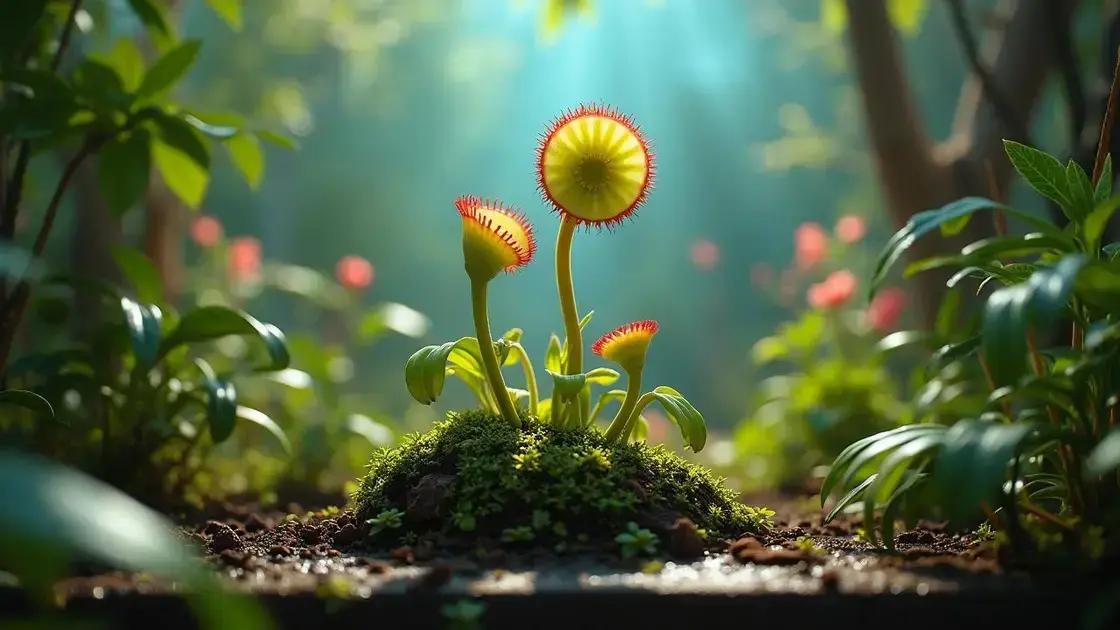How to Care for a Venus Flytrap Plant: 5 Essential Tips for Success
How to care for a venus flytrap plant is a question many plant enthusiasts ask. Understanding its unique needs is crucial for keeping this fascinating carnivorous plant healthy and thriving. This guide will cover the key elements to help your venus flytrap flourish.
Table of Contents
ToggleEssential Water Requirements for Your Venus Flytrap
Essential water requirements for your venus flytrap must be well understood to keep this fascinating plant healthy. These carnivorous plants thrive in moist conditions, and meeting their water needs is crucial for optimal growth. Watering practices and techniques will make a significant difference in the vitality and functionality of your venus flytrap.
Choosing the right type of water
When it comes to watering your venus flytrap, quality is key. Here are the best options:
- Rainwater: This is the preferred choice as it is free from chemicals.
- Distilled water: A reliable alternative, distilled water lacks harmful minerals.
- Reverse osmosis water: Ideal for purifying tap water and removing contaminants.
Understanding watering frequency
Watering frequency for your venus flytrap depends on various factors, including light and humidity. Here’s a quick guide:
- Daily checks: Monitor the soil moisture regularly, especially during hot months.
- Water when needed: Keep the soil consistently moist but not soggy.
- Seasonal adjustments: During winter, reduce watering frequency as the plant’s growth slows down.
Using trays for optimal moisture retention
One effective method to maintain adequate moisture is to use water trays:
- Fill a shallow tray with distilled water.
- Place the pot in the tray, allowing the roots to absorb moisture from below.
- Replace water weekly to ensure it doesn’t become stagnant.
Recognizing signs of over or under-watering
Monitoring your plant’s health will help you understand its water needs:
- Over-watering: Yellowing leaves or mushy roots may indicate too much water.
- Under-watering: Dry, crispy leaves are a sign of insufficient moisture.
Exploring indoor gardening techniques can also offer additional insights into maintaining moisture levels effectively for your venus flytrap.
Conclusion
By understanding the essential water requirements for your venus flytrap, you can create the ideal growing conditions for this unique plant. Appropriate watering not only supports its growth but also enhances its ability to catch prey and flourish.
Optimal Light Conditions for Healthy Growth

Optimal light conditions for healthy growth are essential for your venus flytrap to thrive. These incredible plants are native to sunny environments, and providing the right amount of light not only enhances their growth but also maximizes their ability to trap prey.
Understanding light requirements
Venus flytraps require plenty of bright light to remain healthy and develop vibrant traps. Here are key considerations:
- Direct sunlight: Aim for 12 to 14 hours of sunlight daily.
- Indoor lighting: Use grow lights if natural light is insufficient, preferably with full-spectrum LEDs.
- Avoid low light: Insufficient lighting can lead to leggy, unhealthy growth.
Best light sources for venus flytraps
Different light sources can help fulfill the needs of your plant:
- Sunlight: Placing your plant near a south or west-facing window.
- Grow lights: Using LED or fluorescent grow lights specifically designed for plants.
- Light duration: Adjusting light exposure based on seasonal changes to maintain growth.
Signs your plant is getting the right amount of light
Monitoring your plant’s health is crucial:
- Healthy traps: Green, robust traps indicate optimal lighting conditions.
- Strong growth: New growth and traps developing consistently.
- Avoiding burn: If leaves stay green without browning or burning, light levels are favorable.
For additional insights on exploring indoor gardening techniques, consider joining communities that share tips for indoor plant care.
Conclusion
By providing optimal light conditions for healthy growth, your venus flytrap will flourish and continue to captivate with its elegant traps. Adjusting light levels as needed will ensure your plant’s long-term success.
Best Soil and Fertilization Tips for Venus Flytraps
Best soil and fertilization tips for venus flytraps are crucial for maintaining their health and growth. These unique carnivorous plants require specific soil types and fertilization methods to flourish in their native environments.
Selecting the right soil
For your venus flytrap, using the proper soil mixture is essential. Here are the best components:
- Sphagnum moss: Provides excellent moisture retention and aeration.
- Perlite: Adds drainage and helps prevent compacting.
- Peat-free mixes: Opt for soil that lacks fertilizers or minerals, as these can harm the plant.
Recommended soil mixtures
Consider the following soil mixes for your carnivorous plant:
- 2 parts sphagnum moss + 1 part perlite.
- 1 part orchid bark + 1 part peat-based mix + 1 part perlite.
- A commercially available carnivorous plant soil mix can also work effectively.
Fertilizing your venus flytrap
Proper fertilization helps enhance your plant’s growth:
- Frequency: Fertilize only during the growing season, typically spring and summer.
- Type of fertilizer: Use a diluted liquid fertilizer specifically designed for carnivorous plants.
- Avoid over-fertilization: Too much fertilizer can damage the plant, leading to drooping or browning.
For further information about exploring indoor gardening techniques, check out community discussions that provide additional insights on soil and fertilization.
Monitoring plant health
Keeping an eye on your plant’s health can guide your soil and fertilization strategies:
- Strong growth: New traps and leaves indicate success.
- Color changes: Green and vibrant colors show a healthy response to your care.
- Signs of stress: Yellowing leaves or stunted growth may signal the need for adjustments.
By following these best practices for soil and fertilization, you will help your venus flytrap reach its potential and thrive beautifully.
In conclusion
Caring for a venus flytrap requires understanding its unique needs for water, light, soil, and fertilization. By providing the optimal conditions we discussed, you can ensure your carnivorous plant thrives and captures the attention of anyone who sees it. Don’t underestimate the importance of using the right soil mix and adhering to a proper fertilization schedule. For even more insights and tips on enhancing your indoor garden, explore additional resources to further your knowledge. With diligent care, your venus flytrap will not only grow but also thrive, becoming a captivating centerpiece in your home or garden.

